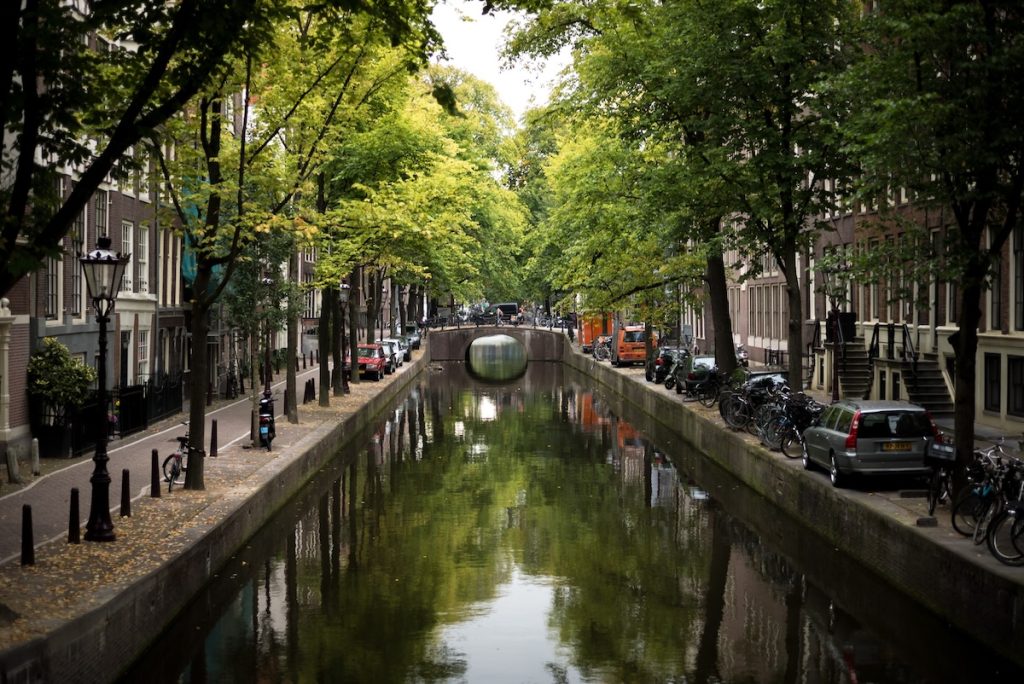
Due to the growing mental health crisis, society has shifted its focus to promoting human well-being. This is said to be even more important for younger generations. At the same time, there’s growing evidence that our mental health is highly responsive to our environment.
For example, when people feel isolated from each other and from nature, and when they live in densely populated cities, both their mental and physical health suffer. Because exposure to the built environment affects our emotional and psychological health, it’s important to study and measure it scientifically.
But well-being is a complex concept, and measuring it isn’t always easy. We can think of it as the pursuit of pleasurable experiences or life satisfaction (hedonism), but it can also be understood as personal growth, wholeness, and living a good life through the pursuit of meaningful goals (eudaimonia).
To design cities that promote well-being, architects, designers, urban planners, and policymakers must consider physical and mental health, as well as psychological, emotional, and social well-being. So how can designers create environments that not only facilitate physical or mental restoration, but also promote psychological well-being?
How to use a psychological framework to guide design
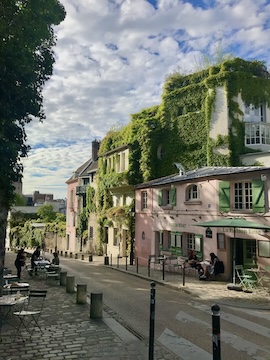
First, it’s beneficial to understand that psychological knowledge is often organized into theories. Psychological theories are supported by empirical evidence. They are a way to describe and explain human behaviors in relation to their surrounding environment or life event. They can tell you why things might happen and how they are connected.
They are also predictive – theories can provide insights on the likely effects of the design. Psychological theories can help designers to find what key factors within the environment are relevant to the project objectives and apply it in practice.
Beginning the design process by considering a particular theory or framework can help in several ways. It can provide a structure for the research the project will be based on, it can guide in making design decisions, and finally it will help to evaluate how successful the design is once put into practice.
Benefits of applying a theory or using a theoretical framework are:
- Structure. A psychological framework can help to prioritize, narrow the scope, and better understand the influence of each design feature that will be created. It can also provide guidance on how to use a particular research methodology to better understand the future users and their needs. With a pertinent framework, designers can be truly intentional in their design. They can design consciously, aware of the impact their design can have.
- Decision Making. Although a design process can be based on intuition, creativity, and experimentation, it’s useful to have guidelines for making design decisions. Applying a framework and checking the design against its guiding principles can streamline the decision-making process when it comes to value engineering or selecting between design options.
- Evaluation. By integrating evidence-based design research into architectural design, psychological frameworks provide clients and stakeholders with baseline measures. A psychological framework can also be useful in determining the effect of environmental design interventions on health outcomes, using pre- and post-measurements. A conscientious design process includes such evaluation.
For example, after a building is completed and when the occupants are accustomed to their environment, a post-occupancy evaluation can be conducted. The feedback collected from the evaluation can be quantitative, through questionnaires or scales, or qualitative, through workshops or interviews, in order to gain understanding of the users’ experience.
The results can inform on how successful the design is in meeting the project’s goals and provide lessons learned for future projects. A post-occupancy evaluation can also provide feedback on how the building affects the users’ behavior and well-being.
How to select a relevant psychological framework
So where does one start? What psychological framework should be chosen for a specific project? This must be decided based on the goals of the design and the needs of the future users. Further, it depends on the specific context, the user’s needs, the design objectives and the geographic or cultural location.
When designing with the goal of fostering health and wellness, one of the psychological frameworks relevant to human well-being is the Self-Determination Theory. In 2000, psychologists Richard Ryan and Edward Deci developed the Self-Determination Theory, which says there are three basic needs that people must satisfy in order to be healthy and feel well: autonomy, relatedness, and competence.
There is nothing more practical than a good theory.
Kurt Lewin
According to Deci and Ryan, autonomy is described as a high degree of perceived choice, self-governance, and independence. This means that we feel autonomous when we perceive to act freely, move freely and comfortably (physical autonomy), or make our own decisions (psychological autonomy).
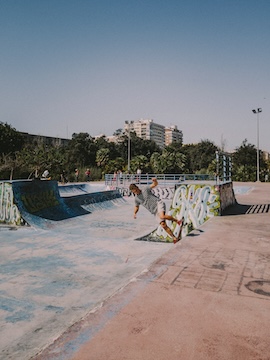
Relatedness is described as the desire to feel connected to others, to care for others, and to be cared for. We can also feel connected to our environment and its natural components. Social relatedness refers to the interactions and support of people, while nature relatedness refers to the attachment and stimulation of a particular space or ecology. Both social and nature relatedness are associated with a strong sense of belonging and attachment to people or the environment.
The third basic need is competence, which refers to having confidence in our own abilities and the motivation to grow and achieve our goals. People can also feel competence or self-efficacy when interacting with the built environment, as they can feel familiarity or understanding of a space.
Imagining that we’ve chosen this theory as a psychological framework for our design, let’s take a look at how we might apply it to urban design and understand how it affects people’s well-being.
Example: Applying the self-determination theory to urban design
In 2020, we conducted a study to evaluate urban spaces in the city of Milan, Italy. The aim was to assess the impact of pandemic restrictions and lack of access to green spaces on the well-being of residents.
Due to the nature of the COVID-19 restrictions, which severely limited daily social interactions, freedom, and work, the self-determination theory was chosen as the most relevant framework for this context.
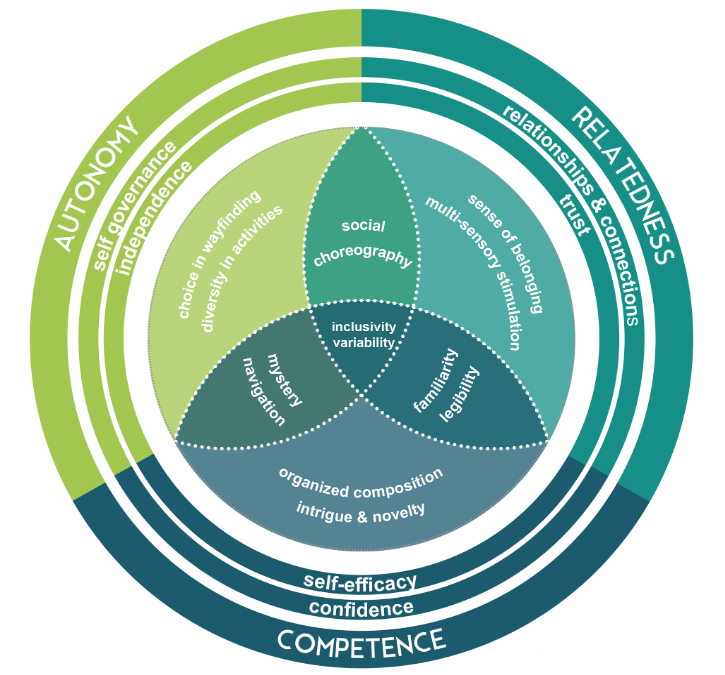
However, in other contexts or studies, this theory may not be the most appropriate. After selecting the self-determination theory as the basic approach, the methodology of the study was designed around its principles.
Two main questions structured the study: How can the environment support autonomy, relatedness, and competence? and What components of each need can the environment support? We decided to focus the design of the study around the three pillars of well-being: autonomy, relatedness, and competence.
The following section demonstrates what the research revealed based on Self-Determination Theory and how it can be applied by architects and urban designers.
Autonomy
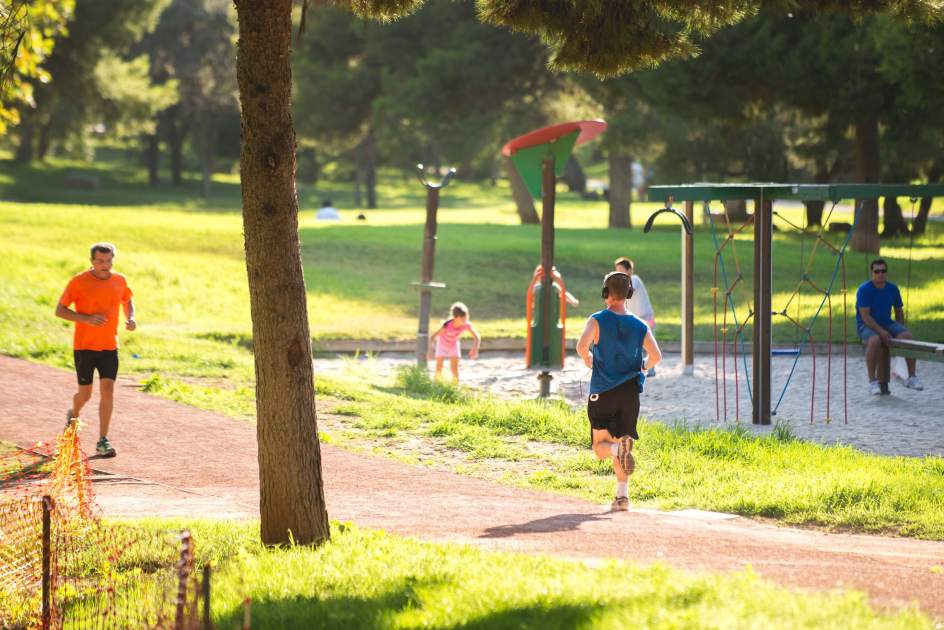
To promote autonomy in a public park or urban environment, designers should encourage variability and flexibility, or a variety of activities. The place should provide enough space for different activities and opportunities for people to engage their bodies and minds in different ways.
For example, a variety of ergonomic urban furniture allows users to find personal comfort by adjusting to their own height, weight or preference. A simple choice of different types of benches or chairs to sit on can also serve this purpose.
Another potential design strategy is to provide several alternative routes for walking from one place to another. This creates a choice in wayfinding and allows the user the freedom to choose which path to take.
Social and nature relatedness

Relatedness can be stimulated by creating a sense of belonging through social interaction and familiarity. In addition to fostering a sense of community, a sense of belonging can enrich a person’s daily life by creating a sense of purpose and connection to the place where they live. Fostering a sense of community is especially challenging in today’s dense cities.
However, the design of the built environment can address the need for community by giving different user groups a sense of empowerment and ownership over the shared urban spaces in which they live.
Social connectedness can also be encouraged by providing opportunities for pair or group activities – think cooperative or competitive games, and places to socialize (picnic tables and benches).
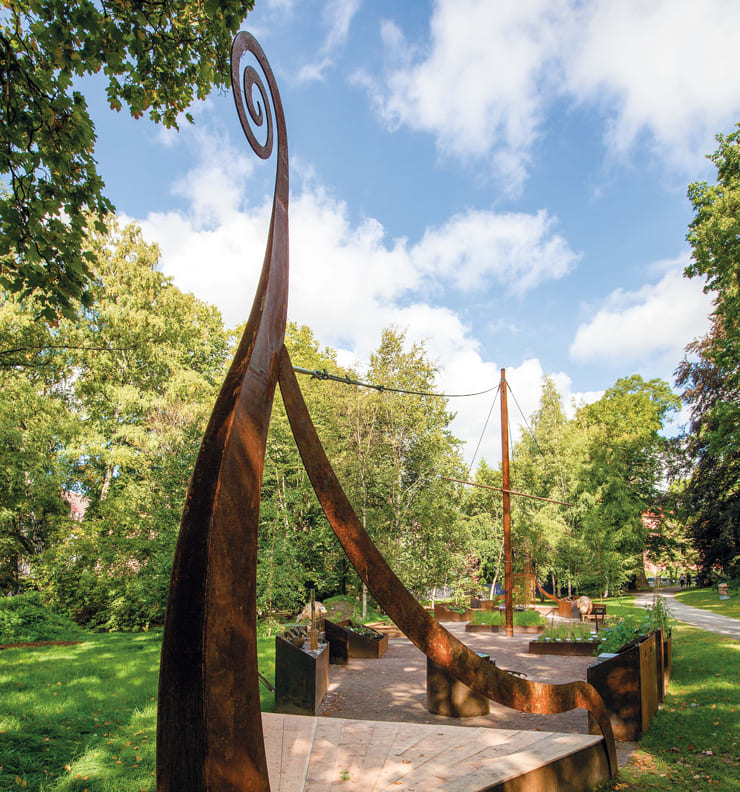
Familiar surroundings can also provide a sense of security. Design strategies that promote a sense of comfort and safety are key to supporting well-being and reducing anxiety.
Familiarity can be enhanced by building the environment around patterns that people already know well and are evolutionarily predisposed to (such as the prospect and refuge spaces). This allows them to intuitively understand the purpose of the place, how to navigate it, and what to expect.
Another key design feature that has a positive impact on human cognition, such as attention and overall well-being, is multisensory stimulation. Auditory, kinesthetic, tactile, and olfactory sensations have been shown to have positive effects on social communication and emotional responses in users. So it’s essential to think about how to engage all the senses in design.
Competence
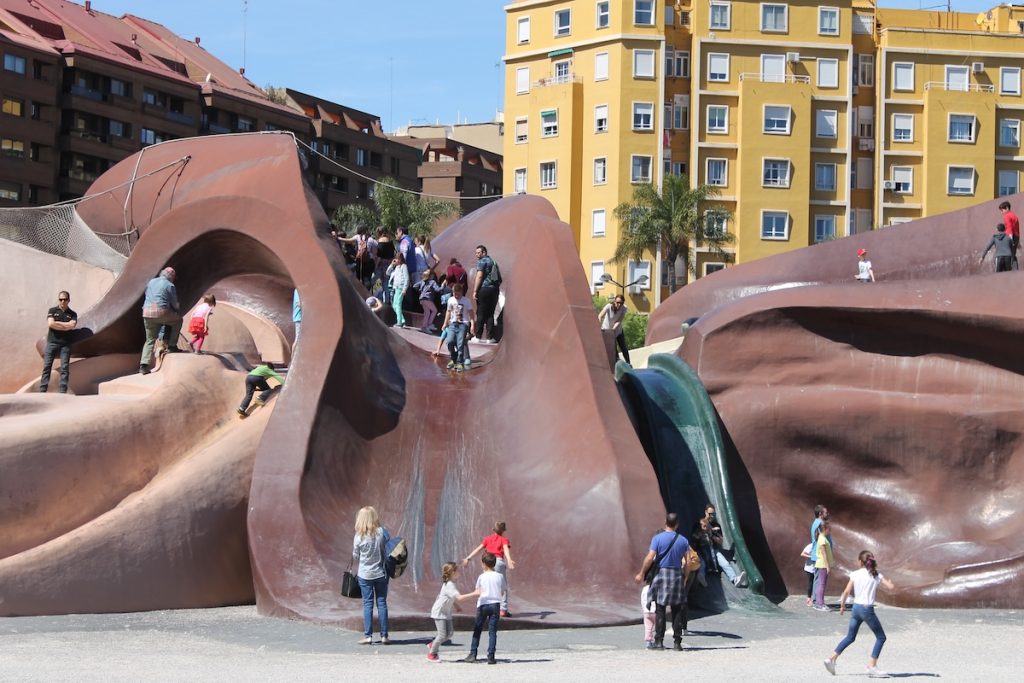
A well-organized environment with clear wayfinding can provide a sense of familiarity and order. Organized composition and legibility can be promoted through the design of signage, areas, materials, lighting, and public transportation stops. The ability to feel control and clarity over an environment can increase feelings of competence and self-efficacy.
In addition, environments that provide optimal challenges and opportunities for exploration and risk-taking are most likely to satisfy the need for mastery and self-efficacy.
Environmental psychologists Rachel and Stephen Kaplan have emphasized how creating a sense of intrigue and novelty throughout a space not only creates a positive sense of curiosity and motivation, but can also encourage users to feel empowered by their environment.
Conclusion
There are still many challenges with integrating theory into design practice such as schedules, budgets, and stakeholder disagreement. However, there are several benefits to utilizing this approach that can enrich the human experience within space.
As shown by the example of this study in Milan, a psychological framework was beneficial to guide the design towards specific needs. In this case study, well-being in the urban context was facilitated by the use of SDT as a framework.
We encourage architects, designers, social scientists, psychologists, neuroscientists, and all other disciplines working in the fields of design or the fields of understanding humans to work closely together to create meaningful spaces.
Subscribe to Venetian Letter
You will receive our regular newsletter with blog posts, interviews, books and events on human-focused architecture and urban design.

Connie Lin is an American architect and researcher. She is currently a Healthcare Fellow at Perkins&Will. Connie received her Master of Arts in Design and Health from Cornell University after attending the Neuroscience Applied to Architectural Design master’s program from the Università Iuav di Venezia. She received her Bachelor of Architecture from Drexel University and has practiced architectural design in Philadelphia, Chicago, New York, and Los Angeles. Connie has also served as an adjunct professor in the Dept. of Architecture, Design, and Planning at Drexel University. Connie’s research interests lie at the intersection between biophilic design interventions, experiential mapping, and mental and behavioral healthcare facilities.

Claire Daugeard is an architect trained in social and cognitive sciences applied to architecture. She graduated with a Master’s in Architecture (2015, Ecole Nationale Supérieure de Paris Val de Seine), a Bachelor in Sociology (2017, Université Paris Nanterre), a Master in Cognitive Psychology (2019, Université Paris Nanterre), and a Master of Neuroscience applied in Architectural Design (2020, Università Iuav di Venezia). She is currently working as a scientific collaborator at the Centre Neuchâtelois de Psychiatrie (CNP), where she conducts research on the impact of the physical environment on patients’ and staff’s mental health and well-being. Further, she works for [S]CITY, a company focusing on the integration of cognitive and behavioral sciences into urban and architectural projects.

Anja Kluge is a psychologist with a passion for architecture. She holds a B.Sc. in Psychology, a M.Sc. in Industrial, Organizational and Social psychology (Ludwigs Maximilians University Munich) and studied Neuroscience applied to architectural design at the Università Iuav di Venezia. After having worked in different consulting companies in the field of organizational development and workplace consulting, Anja started in 2020 with Kluges Konzept. There she connects humans and space, psychology, and architecture. Her passion is to foster people’s well-being by personal growth as well as by supportive spaces.
References
For more information on the design application of the SDT you can have a look at the NAAD Master Thesis of Connie Lin, 2020.
Borgen, L., & Guldahl, A. S. (2011). Great-granny’s Garden: A living archive and a sensory garden. Biodiversity and Conservation, 20(2), 441–449. https://doi.org/10.1007/s10531-010-9931-9
Bower, I., Tucker, R., & Enticott, P. G. (2019). Impact of built environment design on emotion measured via neurophysiological correlates and subjective indicators: A systematic review. Journal of Environmental Psychology, 66, 101344. https://doi.org/10.1016/j.jenvp.2019.101344
Deci, E. L., & Ryan, R. M. (1985). The general causality orientations scale: Self-determination in personality. Journal of Research in Personality, 19(2), 109–134. https://doi.org/10.1016/0092-6566(85)90023-6
Deci, E. L., & Ryan, R. M. (2000). The “What” and “Why” of Goal Pursuits: Human Needs and the Self-Determination of Behavior. Psychological Inquiry, 11(4), 227–268. https://doi.org/10.1207/S15327965PLI1104_01
Deci, E. L., & Ryan, R. M. (2012). 85 Motivation, Personality, and Development Within Embedded Social Contexts: An Overview of Self-Determination Theory. In R. M. Ryan (Ed.), The Oxford Handbook of Human Motivation (p. 0). Oxford University Press. https://doi.org/10.1093/oxfordhb/9780195399820.013.0006
Ehsan, A., Klaas, H. S., Bastianen, A., & Spini, D. (2019). Social capital and health: A systematic review of systematic reviews. SSM – Population Health, 8, 100425. https://doi.org/10.1016/j.ssmph.2019.100425
Gorgul, E., Luo, L., Wei, S., & Pei, C. D. (2017). Sense of Place or Sense of Belonging? Developing Guidelines for Human-centered Outdoor Spaces in China that Citizens Can be Proud of. Urban Transitions Conference, Shanghai, September 2016, 198, 517–524. https://doi.org/10.1016/j.proeng.2017.07.106
Grahn, P., & Stigsdotter, U. K. (2010). The relation between perceived sensory dimensions of urban green space and stress restoration. Landscape and Urban Planning, 94(3), 264–275. https://doi.org/10.1016/j.landurbplan.2009.10.012
Gruebner, O., Rapp, M. A., Adli, M., Kluge, U., Galea, S., & Heinz, A. (2017). Cities and Mental Health. Deutsches Ärzteblatt International. https://doi.org/10.3238/arztebl.2017.0121
Guite, H. F., Clark, C., & Ackrill, G. (2006). The impact of the physical and urban environment on mental well-being. Public Health, 120(12), 1117–1126. https://doi.org/10.1016/j.puhe.2006.10.005
Herranz-Pascual, K., Aspuru, I., Iraurgi, I., Santander, Á., Eguiguren, J. L., & García, I. (2019). Going beyond Quietness: Determining the Emotionally Restorative Effect of Acoustic Environments in Urban Open Public Spaces. International Journal of Environmental Research and Public Health, 16(7). https://doi.org/10.3390/ijerph16071284
Huta, V., & Waterman, A. S. (2014). Eudaimonia and Its Distinction from Hedonia: Developing a Classification and Terminology for Understanding Conceptual and Operational Definitions. Journal of Happiness Studies, 15(6), 1425–1456. https://doi.org/10.1007/s10902-013-9485-0
Kaplan, R., Kaplan, S., & Ryan, R. L.With People in Mind: Design and Management of Everyday Nature. Washington DC: Island Press, 1998.
Kitchen, P., Williams, A., & Chowhan, J. (2012). Sense of Belonging and Mental Health in Hamilton, Ontario: An Intra-Urban Analysis. Social Indicators Research, 108(2), 277–297. JSTOR.
Nkire, N., Mrklas, K., Hrabok, M., Gusnowski, A., Vuong, W., Surood, S., Abba-Aji, A., Urichuk, L., Cao, B., Greenshaw, A. J., & Agyapong, V. I. O. (2021). COVID-19 Pandemic: Demographic Predictors of Self-Isolation or Self-Quarantine and Impact of Isolation and Quarantine on Perceived Stress, Anxiety, and Depression. Frontiers in Psychiatry, 12. https://www.frontiersin.org/articles/10.3389/fpsyt.2021.553468
Peschardt, K. K., & Stigsdotter, U. K. (2013). Associations between park characteristics and perceived restorativeness of small public urban green spaces. Landscape and Urban Planning, 112, 26–39. https://doi.org/10.1016/j.landurbplan.2012.12.013
Pritchard, A., Richardson, M., Sheffield, D., & McEwan, K. (2020). The relationship between nature connectedness and eudaimonic well-being: A meta-analysis. Journal of Happiness Studies: An Interdisciplinary Forum on Subjective Well-Being, 21(3), 1145–1167. https://doi.org/10.1007/s10902-019-00118-6
Ruggeri, K., Garcia-Garzon, E., Maguire, Á., Matz, S., & Huppert, F. A. (2020). Well-being is more than happiness and life satisfaction: A multidimensional analysis of 21 countries. Health and Quality of Life Outcomes, 18(1), 192. https://doi.org/10.1186/s12955-020-01423-y
Ryan, R. M., & Deci, E. L. (2000). Self-determination theory and the facilitation of intrinsic motivation, social development, and well-being. American Psychologist, 55(1), 68–78. https://doi.org/10.1037/0003-066X.55.1.68
Ryan, R. M., & Deci, E. L. (2020). Intrinsic and extrinsic motivation from a self-determination theory perspective: Definitions, theory, practices, and future directions. Contemporary Educational Psychology, 61, 101860. https://doi.org/10.1016/j.cedpsych.2020.101860
Ryan, R. M., Huta, V., & Deci, E. L. (2008). Living well: A self-determination theory perspective on eudaimonia. Journal of Happiness Studies: An Interdisciplinary Forum on Subjective Well-Being, 9(1), 139–170. https://doi.org/10.1007/s10902-006-9023-4
Tang, M., Wang, D., & Guerrien, A. (2020). A systematic review and meta-analysis on basic psychological need satisfaction, motivation, and well-being in later life: Contributions of self-determination theory. PsyCh Journal, 9(1), 5–33. https://doi.org/10.1002/pchj.293
Tawil, N., Sztuka, I. M., Pohlmann, K., Sudimac, S., & Kühn, S. (2021). The Living Space: Psychological Well-Being and Mental Health in Response to Interiors Presented in Virtual Reality. International Journal of Environmental Research and Public Health, 18(23). https://doi.org/10.3390/ijerph182312510
Zhang, T., Liu, J., & Li, H. (2019). Restorative Effects of Multi-Sensory Perception in Urban Green Space: A Case Study of Urban Park in Guangzhou, China. International Journal of Environmental Research and Public Health, 16(24). https://doi.org/10.3390/ijerph16244943